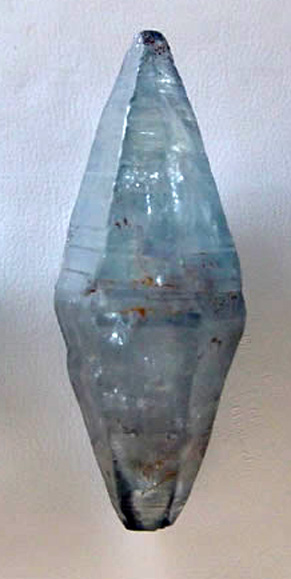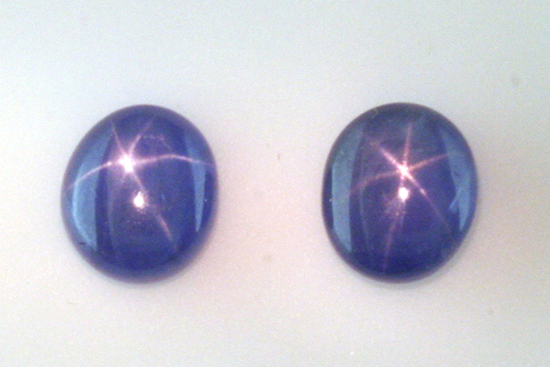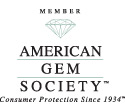What is the Best Color for Blue Sapphire? Part 2
September 5th, 2009 by James L. Sweaney, CGA, FGA. GGThe characteristics of any gemstone are directly related to the crystal from which it is cut, so it’s important to understand how the physical nature of the crystal influences the color of the gem. In the case of blue sapphire, one of the more common crystal forms is an elongated six sided dipyramidal form, as shown below.

Well Formed Sapphire Crystal
Sapphire crystals form in the hexagonal system, with the long axis (z) intersected at 90 degrees by six axes (x,y) rotated 30 degrees apart. In this crystal, the z axis centers the crystal from long point to long point, and the six flat sides of the dipyramids are perpendicular to the x & y axes
An interesting property of many gem species is that they are doubly refractive, where light is polarized into separate rays of light which travel at different speeds, depending on the direction of the light through the crystal. Different speeds of light mean different wavelengths, different wavelengths of light mean different colors. This is the property of pleochroism, meaning that the material shows more than one color.
In blue sapphire, along the z axis, no polarization occurs and light behaves as if it were singly reactive. We call this the optic axis.
Looking in directions other than along the optic axis, we will see two colors (dichroism), violetish blue predominating along one axis, greenish blue along another. The color divergence between the two polarized rays is strongest when viewing the gem or crystal perpendicular to the optic axis. In gem cutting and gemological testing and identification, we use an instrument called a dichroscope which shows the two polarized rays side by side, and can also aid in identifing the optic axis.
In practical terms, this means that the best blue sapphires will be oriented with their table (the big flat facet on the top of the stone) perpendicular to the optic (z) axis, so that when we look at the stone face up, we are seeing non-polarized light, i.e. the purest color. Stones cut from poorly shaped crystals or fragments may be improperly oriented so that the violetish blue or greenish blue rays dominate.
Another characteristic of blue sapphire crystals is that they are often unevenly colored- note the patches of color in the crystal shown above. Corundum, the mineral of which sapphire (and ruby) are varieties, is allochromatic, meaning it is colorless when chemically pure. The color of blue sapphires is due primarily to impurities of titanium. The blue colors can concentrate in “zones” that manifest as bands parallel to the flat faces of the crystal. We often see dark blue streaks next to areas with little or not color.
Color zoning is almost always considered a negative feature, especially in upper tier blue sapphires. Good cutting technique and skill can minimize the effect of color zoning on the overall appearance of a sapphire, but all things being equal, a stone with no color zoning is more desirable than one with color zoning.
Inclusions in gems can profoundly influence the color appearance of the gem. One of the more common inclusions in blue sapphire is “silk,” which are ultra-fine crystals of the mineral rutile which form as the sapphire crystal cools. These appear as faint straight fibers which follow the hexagonal growth of the crystal.
Silk is what gives a star sapphire its star– the lens shape of the cabochon cut focuses light on the minute silk fibers which are oriented at 60 degree angles to each other and the light is reflected out of the stone as sharp rays of light. The best star sapphires are relatively transparent, with just enough silk to generate a good star.
In excess, silk creates a milky look– If a sapphire gemstone or crystal is otherwise “gemmy” enough, it may be heat treated to high temperatures, causing the silk to reabsorb into the body of the sapphire, creating a more transparent gem, often enhancing or darkening the color appearance. The presence of silk “remnants” is one of the proofs of heat treatment.
On the positive side, very fine inclusions, rather like faint dust clouds within the gem, can give a sapphire a “sleepy” appearance than can be very desirable. Kashmir sapphires are known for their soft “velvety” appearance which, combined with their classic “Cornflower” blue, creates a unique look for these highly sought after gems. These stones are extremely rare today because little new material is being produced.
So we can see that the best blue sapphires are directly influenced by their parent crystals in several ways. They should be properly oriented, with the table perpendicular to the z axis, to show the best color. They should have even color, with no color zoning apparent, especially from the face up view. And they should be highly transparent- noticeable silk should be present only in star stones.
Tags: color zoning, heat treatment, hexagonal crystal system, pleochroism, silk








